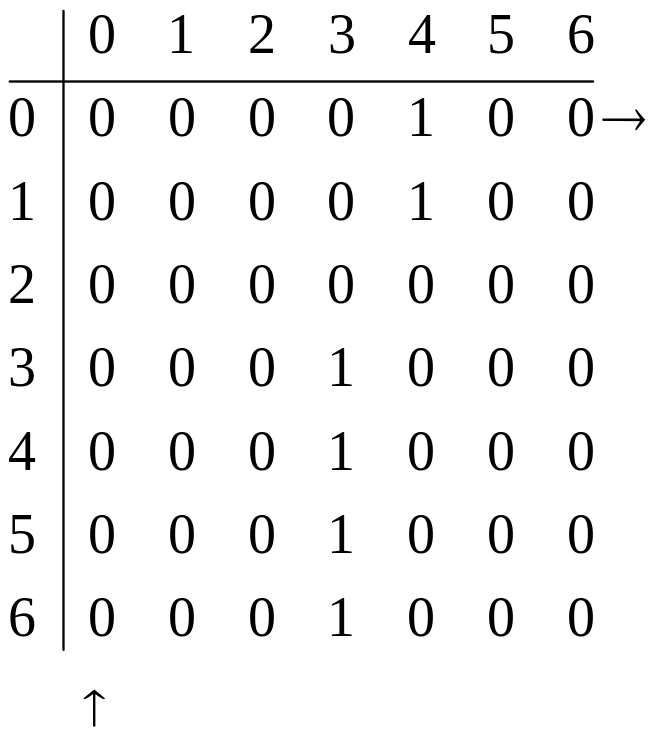
- •1 Data transmission systems
- •1.1 Classification of basic error-correcting codes
- •1.2 Cyclic codes
- •1.2.1 Basic construction principles of cyclic codes
- •1.2.2 The relative information transfer rate of cyclic codes
- •1.2.3 Basic principles of construction of cyclic сodes coders
- •1.2.4 Syndrome decoding of cyclic codes
- •1.2.5 Meggitt decoder of cyclic codes
- •1.3 Convolutional codes
- •1.3.1 Basic parameters of convolutional codes
- •1.3.2 Decoding of the systematic convolutional codes
- •1.3.3 Decoding of the nonsystematic convolutional codes
- •1.3.3 Soft output Viterbi algorithm
- •1.4 Concatenated codes
- •1.4.1 Serial concatenated encoding fundamentals
- •1.4.2 Construction of interleaver and deinterleaver
- •1.4.3 Turbo codes
- •1.4.4 Perforation of output sequences
- •1.5 Frames structure on hdlc procedure
- •1.5.1 Types of frames according to hdlc procedure
- •1.5.3 Support frames structure
1.4.2 Construction of interleaver and deinterleaver
Under the assumption that the channel has memory, the errors no longer can be characterized as single randomly distributed bit errors whose occurrence is independent from bit to bit. Most block or convolutional codes (CnC) are designed to combat random independent errors. The result of a channel having memory on such coded signals is to cause degradation in error performance. Coding techniques for channels with memory have been proposed, but the great problem with such coding is the difficulty in obtaining accurate models of the often time-varying statistics of such channels.
Interleaving the coded message before transmission and deinterleaving after reception causes bursts of channel errors to be spread out in time and thus to be handled by the decoder as if they where random errors. Since, in all practical cases, the channel memory decreases with the time separation. Separating the symbols in time effectively transforms a channel with memory to a memoryless one, and thereby enables the random-error-correcting codes to be useful in a burst-noise channel.
Interleaving techniques have proven useful for all the block and convolutional codes described in earlier chapters. Two types of interleavers are commonly used, block interleavers and convolutional interleavers. They are each described below.
A block interleaver accepts the coded symbols in blocks from the encoder, permutes the symbols, and then feeds the rearranged symbols to the modulator. The usual permutation of the block is accompanished by filling the columns of an M-row-by N-column (M×N) array with the encoded sequence. After the array is completely filled, the symbols are then fed to the modulator one row at a time and transmitted over a channel.
Typically, for use with a single-error-correcting code the interleaver parameters are selected such that the number of columns N overbounds the expected burst length. The choise of the number of rows M is dependent on the coding scheme used. For block codes, M should be larger than the code block length, while for M should be larger than the constraint length. Thus a burst of length N can cause at most a single error in any block codeword: similarly, with convolutional codes, there will be at most a single error in any decoding constraint length. Tor t-error-correcting codes, the choice of N need only overbound the expected burst length divided by t.
Let’s consider diversity of error burst on the sequence of single errors, using square interleaver 7 7 (fig. 1.12). In this case bits received with errors for clearness are discussed as “1”.

Figure 1.12 – Square matrix of interleaver
In the third and fourth columns there are codewords with four and two errors, appearing as a result of the concentrated noise, which can not be corrected by the outer decoder with tc = 1. Reading the binary bits of this matrix on the rows, we`ll get six code combinations with single errors which can be corrected by decoder.
Such transformations of sequence of binary symbols on transmission and reception result in the substantial increase of noise immunity in a channel with independent errors, and also and burst of errors. The sequence of errors regrouped using deinterleaver facilitates possibility of their correction in an outer decoder.
A convolutional interleaver consists of T parallel lines, with different delay in each line that represents interleaver period. In general, each successive line has a delay which is M symbols durations higher than the previous line. The structure for M = 1 and T = 3 is illustrated in figure 1.13.

Figure 1.13 – Convolutional interleaver structure with T = 3 and M = 1
In a similar manner to the trellis termination technique (which emits stored data from memories), an insertion of a certain number of zeros at the end of a data block can isolate the interleaved data block. This guarantees a data block of a specific length and generates independent blocks of data for the coder.
For the data length L = 6 and the convolutional interleaver with M = 1 and T = 3, the interleaved data would be X1 0 0 X4 X2 0 0 X5 X3 0 0 X6.
The performance of a convolutional interleaver is very similar to that of a block interleaver. The important advantage of convolutional over block interleaving is that with convolutional interleaving the end-to-end delay is M(N – 1) symbols, and the memory required is M(N – 1)/2 at both ends of the block interleaving requirements.
